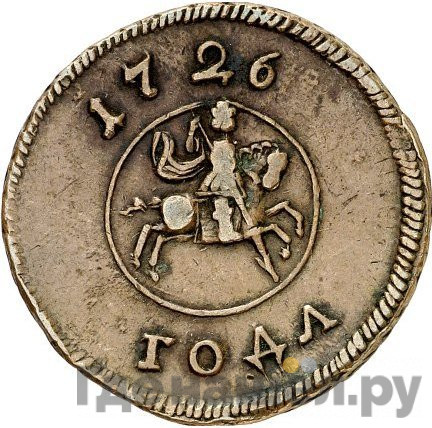The New York Sale The New York Sale XXIX Лот №2045


Аукцион: The New York Sale The New York Sale XXIX
Лот: 2045
Завершен: 05.01.2012
| Стартовая цена: |
3 201 610 RUB
100 000 USD |
| Цена продажи: |
3 681 852 RUB
115 000 USD |
Part I: Russian Coins & Medals . Catherine I, . Extraordinary Pair of 1726 Kopeck Patterns . Pattern Kopeck 1726. Moscow, Kadashevsky mint. 27 mm. 7.97 gm. Narrow, rounded brim on hat, head breaking circle. Bit 379 (R4), B 2 (RR), Diakov 2 – no picture, GM—missing, Ilyin (Very Rare – 150 Rubl.), Uzd 2457 (!!). Rider right holding spear pointing downwards within circle, date above, ГOДА below / KOПEИKA inscribed in double-lined tablet, braided border. Attractive milk-chocolate brown. Choice very fine Ex Brekke Collection, ‘The Bernhard F. Brekke Collection, the Copper Coinage of Imperial Russia 1700-1917, Part I’, World-wide Coins of California, Santa Rosa, CA, May 13, 1993, lot 1155 In the years following the establishment of the new Russian monetary system by Peter the Great in 1700, the Treasury was in constant search for better designs and optimal usage. The main experimentation area revolved around copper coinage especially as the Rouble to pood ratio was in flux. Under Catherine I, this scenario continued, and the design of the two patterns here is an adaption of her husband’s Kopeck of 1724. Catherine’s Copper experiments also included a Grivennik, Grosh, 2 Kopecks, Polushka and plate money in six denominations. But neither they nor the 1726 Kopeck were ever adopted. In the years following the establishment of the new Russian monetary system by Peter the Great in 1700, the Treasury was in constant search for better designs and optimal usage. The main experimentation area revolved around copper coinage especially as the Rouble to pood ratio was in flux. Under Catherine I, this scenario continued, and the design of the two patterns here is an adaption of her husband’s Kopeck of 1724. Catherine’s Copper experiments also included a Grivennik, Grosh, 2 Kopecks, Polushka and plate money in six denominations. But neither they nor the 1726 Kopeck were ever adopted. The 1726 Kopeck Pattern was prepared in two types. In the principal references, they are referred to as ‘Brim on hat’ and ‘No Brim’ on hat. More accurately, on both types, the hat has a brim – one is narrow and rounded, the other is broad and triangular (see lot below). On the narrow brim type (the piece above), the rider’s head breaks the circle, which it doesn’t do on the broad brim type. As Uzdenikov points out, this unadopted Kopeck Pattern of 1726 is Excessively Rare. (Brekke undervalued these Patterns as he was fortunate enough to possess a piece in his private collection). Of the two recorded obverse die types, as noted by James F. Elmen in his May 1993 sale of the Brekke Collection, the coin listed above with the narrow brim and rider’s head breaking the circle is found only in the collections of General Schubert (holed) and Count Tolstoy. The ex-Brekke example offered here is the first and only recorded specimen in the West and likely the only one in private hands. This is the first time both types have been offered together in a public sale (and only the second time that each one has been publically offered), and the fortunate numismatist is offered a unique, once-in-a- lifetime opportunity of adding one or both of these extraordinarily rare pieces to their collection.